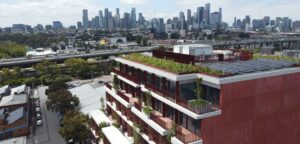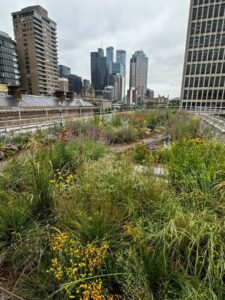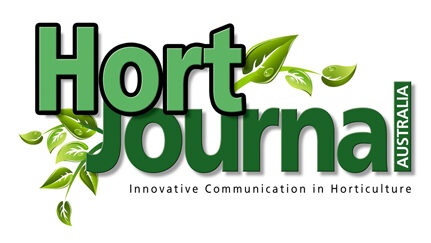
Green roofs are more than just a pretty face
By Michael Casey
Rooftop gardens present creative ways to add nature to urban architecture and can make cityscapes, suburbs, and rural areas more attractive and even unique. However, they go a lot further than a simple aesthetic makeover on an underutilised roof area.
My company was recently involved with building the Demonstration green roof on the State Treasury building in Melbourne. This green roof will serve as a demonstration green space and research site to investigate the feasibility and design possibilities for creating green urban infrastructure in Melbourne.
When reviewing the feedback provided by the industry around this project, it was interesting to note a comment made about whether or not this roof should have gone ahead in the first place as the garden cannot be viewed by anyone (note – it can be viewed from adjacent offices, residential and commercial high-rises). This green space, widely understood in the urban greening industry, offers multiple social, economic, and environmental benefits as an engineered solution; however, it seems to be misunderstood by other professions. With that in mind, exploring the many benefits of green roofs could help clarify misconceptions and encourage broader acceptance of this green infrastructure solution, and hopefully have you design one for your next project.

Green roofs are unique and it’s hard to identify what other technologies provide as many benefits to both the public and private sectors as green roofs do. The benefits provided are primarily influenced by the budget set, design criteria, the structure of the building and site conditions. Some of the well-known benefits are associated with all green roofs, while other features can be identified from specific design inclusions. When identifying the benefits of green roofs, it’s very important to have all stakeholders and associated professions understand the specific environmental, economic and social functions of this specific form of technology. This stakeholder engagement provides the designers, building owners and financiers a clearer view of the asset they are investing in.
One of the largest hurdles in implementing a green roof is the initial cost, which in some cases can be double that of a traditional roof. Early identification of short- and long-term benefits and costs associated with the savings produced by these roofs often gives a clearer picture of what this investment will return over its lifecycle.
The industry and local governments are working to make green roofs more affordable through measures such as financial incentives. Programs like the City of Melbourne’s Urban Forest Fund are a positive step toward offsetting the initial installation costs. Product innovation will also ensure the costs of manufacturing green roof materials are performed at an affordable rate, which will make resources and materials more accessible, along with a reduction in price.
Integrating green roofs with other building systems and programs will help save costs across multiple facets of a building’s use and operation. This could mean savings such as increased performance of photovoltaic panels when used alongside greenery, and even storm water mitigation, which should lead to savings with the associated water boards that manage our sewer and storm water systems. And when this urban greening market expands, it will encourage training facilities to provide training and education, ensuring the delivery of more successful projects.
When identifying additional benefits, numerous factors come into play. These often depend on the design of the green roof, including its size, the materials used, the type of vegetation, and whether it is an intensive roof (typically below 200mm in depth) or an extensive one (greater than 200mm). Environmental conditions also play a significant role, as factors such as location and exposure to the elements can either support or hinder the effectiveness of a green roof. These considerations must be carefully addressed in the early stages of planning. Beyond these influencing factors, let’s explore the undeniable benefits that green roofs offer.
Building owners are more likely to recognise and appreciate the positive return on investment that comes from these private benefits.
Aesthetic improvements play a key role, as visible greenery helps reduce stress, increases property values, and can even contribute to lower crime rates by transforming streetscapes and properties into leafy, inviting environments.
Green roofs also enhance energy efficiency, with studies showing they moderate heat flux through parts of the building envelope. This helps reduce peak demands for heating and cooling, leading to long-term energy savings.
Stormwater mitigation is another essential benefit, particularly in flood-prone cities. By capturing and temporarily holding rainwater, green roofs reduce the strain on stormwater systems during peak flows. This can also protect the building from flooding when excess water backs up in stormwater pipes. Additionally, filtering detained water benefits both local water catchments and buildings that recycle rainwater as a valuable resource.
One of the long-term financial advantages of green roofs is the extended lifespan of roofing materials. Although the initial installation cost may be higher, a green roof increases the durability of waterproofing membranes, reducing the need for frequent replacements and providing cost savings over time.
Fire risk is a constant concern for buildings, but with careful plant selection and the use of fire-retardant materials, green roofs can help suppress fires. Wet growing media, fire-resistant plants like succulents, and integrated irrigation systems all contribute to lowering the risk of fire spreading.

As mentioned earlier, photovoltaic (PV) panels operate more efficiently when installed alongside plant materials. The vegetation helps cool the roof surface, which in turn, improves the performance of solar panels, as excessive heat can reduce their efficiency. Green roofs also contribute to noise reduction, which is particularly valuable in busy urban areas.
Due to the vegetation’s insulating effect, buildings located under flight paths or near train lines may experience a noticeable decrease in noise intensity. Beyond these practical advantages, green roofs enhance a building’s marketability. They are often perceived as exceeding minimum building standards and serve as a symbol of the green building movement, making them more attractive to tenants, buyers, and investors.
Green roofs offer significant benefits for health and well-being. Numerous studies highlight the positive effects of greenery on both physical and mental health. These spaces are not only visually appealing, but can also be utilised for urban agriculture, allowing occupants to grow fresh, nutritious food and foster a sense of community.
Research suggests that at least 5–20% of a city’s roof space must be greened to create a meaningful impact when considering the public benefits of green roofs. While any green infrastructure project is a step in the right direction, it’s important to recognise that the more assets we have, the greater the overall benefits, particularly in cooling and greening our cities.
Among the key public advantages is reducing waste by limiting the removal and disposal of waterproof membranes into landfills. Green roofs extend the lifespan of roofing materials, minimising the need for repairs and replacements.
Additionally, increasing urban greenery helps combat the urban heat island effect, where materials like concrete, glass, and steel trap heat, leading to elevated temperatures in cities. By covering rooftops with vegetation, we can mitigate this effect and create cooler, more liveable urban environments.
Air quality also improves with more vegetation. Cities grappling with pollution now have an additional tool to combat toxic air buildup, a major contributor to health issues and premature deaths in urban areas.
Biodiversity flourishes when green spaces are integrated into built environments. Green roofs provide crucial habitats, migration corridors, feeding zones, and refuges for various species. The presence of wildlife, whether birds, bees, or butterflies, enhances urban life and underscores the value of greening initiatives.
Another significant benefit is boosting the local economy and job creation. Projects like New York’s High Line have not only transformed the cityscape, but also spurred economic growth, attracting new restaurants, cafés, and businesses along the route. Green roofs also generate ongoing employment opportunities for maintenance, gardening, and ecological management.
So, the next time a client hesitates over the initial cost of a green roof, remind them of the immense, long-term, private and public benefits. Green roofs are a high-impact, multi-benefit investment, and as we push beyond 25% rooftop coverage, our cities will reap even greater rewards.
Michael Casey,
Director of Evergreen Infrastructure,
Company Director, Australasian Green Infrastructure Network
On the Technical Panel for the AIPH World Green Cities Awards
Contact: michael@evergreeninfrastructure.com.au
